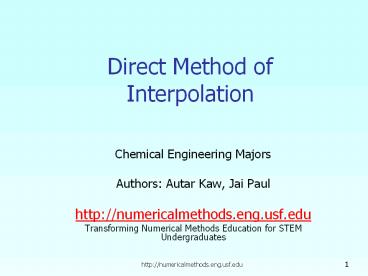Direct Method of Interpolation PowerPoint PPT Presentation
Title: Direct Method of Interpolation
1
Direct Method of Interpolation
- Chemical Engineering Majors
- Authors Autar Kaw, Jai Paul
- http//numericalmethods.eng.usf.edu
- Transforming Numerical Methods Education for STEM
Undergraduates
2
Direct Method of Interpolation
http//numericalmethods.eng.usf.edu
3
What is Interpolation ?
Given (x0,y0), (x1,y1), (xn,yn), find the
value of y at a value of x that is not given.
Figure 1 Interpolation of discrete.
4
Interpolants
- Polynomials are the most common choice of
interpolants because they are easy to
- Evaluate
- Differentiate, and
- Integrate
5
Direct Method
- Given n1 data points (x0,y0), (x1,y1),..
(xn,yn), - pass a polynomial of order n through the data
as given - below
- where a0, a1,. an are real constants.
- Set up n1 equations to find n1 constants.
- To find the value y at a given value of x,
simply substitute the value of x in the above
polynomial.
6
Example
- To find how much heat is required to bring a
kettle of water to its boiling point, you are
asked to calculate the specific heat of water at
61C. The specific heat of water is given as a
function of time in Table 1. Use linear,
quadratic and cubic interpolation to determine
the value of the specific heat at T 61C.
Table 1 Specific heat of water as a function of
temperature.
Temperature, Specific heat,
22 42 52 82 100 4181 4179 4186 4199 4217
Figure 2 Specific heat of water vs.
temperature.
7
Linear Interpolation
Solving the above two equations gives,
Hence
8
Quadratic Interpolation
Quadratic Interpolation
Solving the above three equations gives
9
Quadratic Interpolation (contd)
The absolute relative approximate error obtained
between the results from the first and second
order polynomial is
10
Cubic Interpolation
11
Cubic Interpolation (contd)
The absolute relative approximate error obtained
between the results from the first and second
order polynomial is
12
Comparison Table
13
Additional Resources
- For all resources on this topic such as digital
audiovisual lectures, primers, textbook chapters,
multiple-choice tests, worksheets in MATLAB,
MATHEMATICA, MathCad and MAPLE, blogs, related
physical problems, please visit - http//numericalmethods.eng.usf.edu/topics/direct
_method.html
14
- THE END
- http//numericalmethods.eng.usf.edu
PowerShow.com is a leading presentation sharing website. It has millions of presentations already uploaded and available with 1,000s more being uploaded by its users every day. Whatever your area of interest, here you’ll be able to find and view presentations you’ll love and possibly download. And, best of all, it is completely free and easy to use.
You might even have a presentation you’d like to share with others. If so, just upload it to PowerShow.com. We’ll convert it to an HTML5 slideshow that includes all the media types you’ve already added: audio, video, music, pictures, animations and transition effects. Then you can share it with your target audience as well as PowerShow.com’s millions of monthly visitors. And, again, it’s all free.
About the Developers
PowerShow.com is brought to you by CrystalGraphics, the award-winning developer and market-leading publisher of rich-media enhancement products for presentations. Our product offerings include millions of PowerPoint templates, diagrams, animated 3D characters and more.

